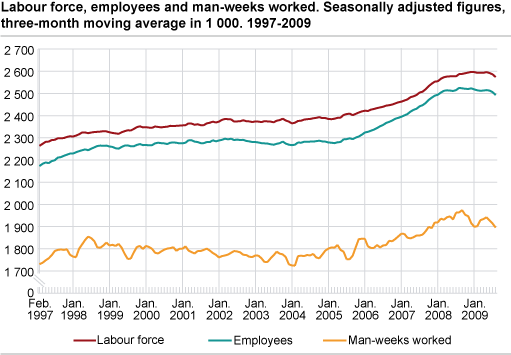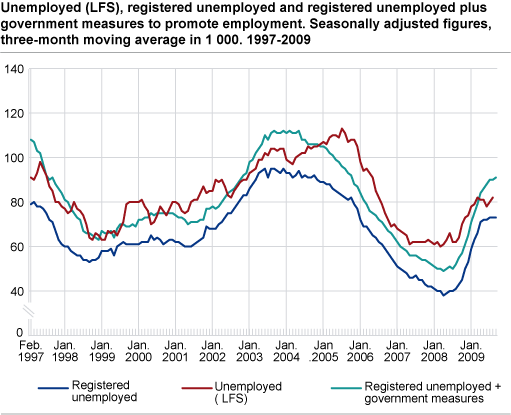Content
Published:
This is an archived release.
Lower labour force participation
From the third quarter of 2008 to the third quarter of 2009 the labour force participation decreased from 74.3 to 72.6 per cent. The reduction was among young people in particular.
Seasonally-adjusted figures: Employment downFrom May to August, the number of employed persons decreased by 22 000. The unemployment rate was 3.2 per cent of the labour force in August. Adjustments for seasonal variations allow for the analysis of current developments in the labour market, and serve as an alternative to comparisons with the corresponding quarter in the previous year. Seasonally-adjusted figures are presented in a separate article . |
The labour force, the sum of employment and unemployment within the age group of 15-74 years, fell by 20 000 between the third quarter of 2008 and third quarter of 2009. In the same period of time and age group, there was an increase in the population of 52 000, hence the number of persons outside the labour force in total increased by 72 000.
Behind the labour force decrease is a fall in employment of 38 000, and an increase in unemployment of 18 000. The reduction in the labour force is made up of 17 000 men and 3 000 women. Thus the labour force participation rate for men, between the third quarter of 2008 and third quarter of 2009, was reduced from 77.5 to 75.5 per cent. In the same period, women had a decrease of labour force participation from 70.8 to 69.7 per cent.
It is the young part of the working-age population that the worsening of the labour market has mostly affected over the past year. From the third quarter of 2008 to the third quarter of 2009 there is a reduction of the labour force within the age-group 15-24 years of 21 000 persons. Behind the decrease of the labour force is a fall in employment of 27 000, and an increase in unemployment of 6 000. Young men especially contribute to this number.
Reduction in employment
The level of employment shows a particular decrease. From the third quarter of 2008 to the third quarter of 2009, employment fell by 38 000. This is the highest reduction in employment on a yearly basis since 1989. Construction and manufacturing lost 12 000 and 18 000 employees respectively, and domestic trade lost 20 000 employees.
There has been a decrease of 23 000 persons on temporary contracts in the past year. In the third quarter of 2009 this corresponds to 8.6 per cent of total employment, which is a reduction from 9.4 per cent in the corresponding quarter of 2008. The share of people on temporary contracts in hotel and restaurants was reduced from 19.8 per cent in the third quarter of 2008 to 16.0 per cent in 2009.
A new industry classification was introduced as from the publication of the first quarter of 2009. Here is an article presenting general information about the new Norwegian industry classification .
Fewer in full-time employment
The share of people working full-time has fallen from 74.0 to 73.5 per cent in the past year. The share in full-time employment among men decreased from 87.0 per cent in the third quarter of 2008 to 86.7 per cent in the third quarter of 2009. In the same period, the share with full-time employment among women decreased from 59.4 to 59.0 per cent. The average settled working hours for men was 37.2 hours per week, compared with 31.4 hours for women.
Increased unemployment among men
According to the Labour Force Survey, the unemployment figure increased by 18 000 from the third quarter of 2008 to the third quarter of 2009. The largest increase was among men. The unemployment rate was 3.3 per cent in the third quarter of 2009, while it was 2.5 per cent in the same quarter of 2008. Among men in the age group 15-24 years, the unemployment rate was 10.0 per cent in the third quarter of 2009, which is an increase of 2.2 percentage points since the corresponding quarter of 2008.
Stable number of underemployed
Underemployment is employees with part-time settled working hours who have tried to find more work. The number of underemployed was 62 000 in the third quarter of 2009, which is not significantly different from 59 000, the number from the third quarter of 2008.
The group of underemployed and unemployed together, wanted work corresponding to 95 000 full-time equivalents in the third quarter of 2009 - up 22 000 from the year before.
Tables:
- Table 1. Population aged 15-74(1) in the labour force, man-weeks worked, unemployed (LFS)(2), registered unemployed persons and persons employed by government measures (NAV). 1 000 and per cent
- Table 2. Population aged 15-74(1) in the labour force, employed persons and unemployed persons by sex (LFS)(2). 1 000 and per cent
- Table 3. Persons in the labour force and employed persons aged 15-74, by age and sex (LFS). 1 000 and per cent.
- Table 4. Population aged 15-74, employed persons by contractual/usual working hours per week(1) and unemployed persons by age and sex (LFS). 1 000
- Table 5. Persons in the labour force aged 15-74 by age and sex. 1 000 and as per cent of all in each group
- Table 6. Employed persons aged 15-74 by sex and contractual/usual working hours pr week (LFS). 1 000
- Table 7. Population aged 15-74, by main activity, part-time employment and age (LFS). 1 000
- Table 8. Empoyed persons aged 15-74 by major industry division (LFS). 1 000
- Table 9. Number of man-hours worked per week by industry division (LFS). 1 000
- Table 10. Employed persons aged 15-74, total, and employed persons at work by status and sex. Number of man-weeks worked1 and actual working hours per week (LFS).
- Table 11. Employed persons aged 15-74 and absence from work during the whole reference week by reason for absence and sex (LFS). 1 000 and per cent
- Table 12. Employees aged 15-74 with temporary jobs, by major industry division (LFS).1 000
- Table 13. Employees aged 15-74 with temporary jobs, by major industry division (LFS). Per cent of all employees
- Table 14. Unemployed persons aged 15-74 by sex and age (LFS). 1 000 and per cent
- Table 15. Unemployed persons aged 15-74 by duration of job search (LFS). 1 000 and per cent
- Table 16. Unemployed persons aged 15-74, by main activity (LFS). 1 000
- Table 17. Unemployed and underemployed persons aged 15-74, by sex and desired working hours per week. Number of man-weeks (of 37,5 hours) supplied (LFS). 1 000
- Table 19. Persons in the labour force aged 15-74, by sex and region (LFS). 1 000 and in per cent of total
- Table 20. Employed persons aged 15-74, by sex and region (LFS) 1 000
- Table 21. Employed persons aged 15-74, by sex and regions (LFS) as per cent of all inn each group
- Table 22. Employed persons 15-74 years, by some major industry division and region (LFS). 1997-2008. 1 000
Contact
-
Arbeidsmarked og lønn
E-mail: arbeidsmarked@ssb.no
-
Erik Herstad Horgen
E-mail: erik.horgen@ssb.no
tel.: (+47) 93 08 68 62
-
Håvard Hungnes Lien
E-mail: havard.lien@ssb.no
tel.: (+47) 40 90 26 06


